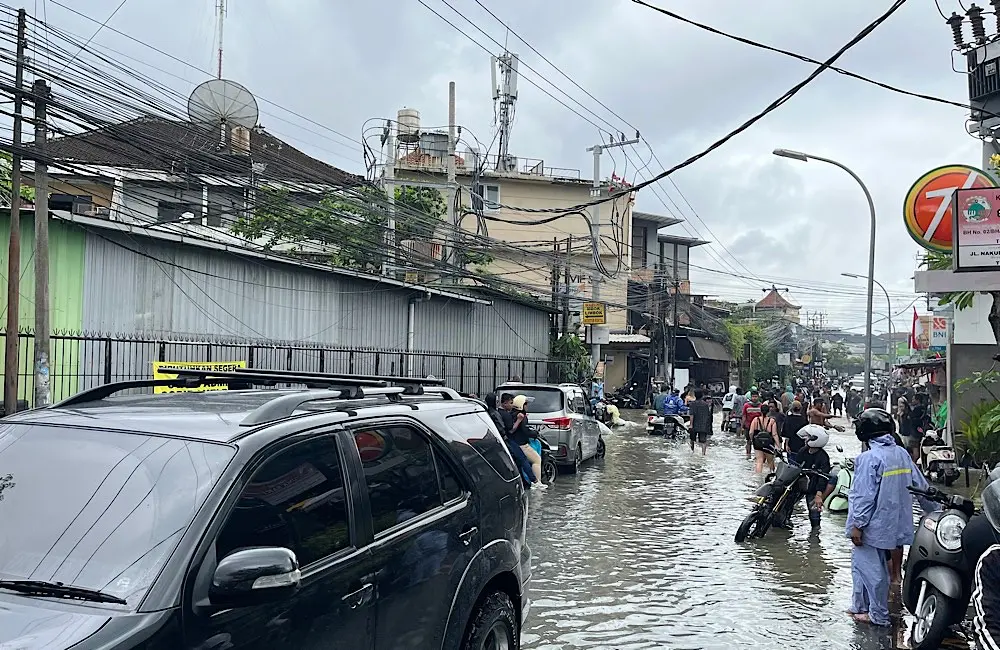Heavy rainfall this week has triggered widespread flooding across Bali, affecting tourism hubs, blocking roads, and raising questions about safety for visitors. Officials now report rivers are returning to normal levels and cleanup is underway, though disruptions remain across the island and forecasters warn of more rain.
According to Indonesia’s National Disaster Mitigation Agency (BNPB), about 600 people have been impacted by the flooding, with nearly 200 evacuated to temporary shelters.
Some tourists report being stranded in villas and resorts, particularly in Legian, Canggu, and Kuta, while others have taken to social media to advise of long delays in reaching the airport. Damage was reported in Denpasar and in districts such as Jembrana, Gianyar, and Badung, which include major visitor hubs.
BNPB Chief Lieutenant General Suharyanto arrived in Bali on Wednesday evening to lead the central government’s response.
“As of 9:00 PM WITA tonight, water levels in the rivers have returned to normal,” he said.
“This flooding was caused by very heavy rainfall.”
He confirmed nine deaths and six missing, with joint teams of 400–600 personnel continuing search operations and beginning clean-up work.
Heavy rainfall has also triggered floods in East Nusa Tenggara province, where at least four people have been killed in Nagekeo district. Roads and phone services were cut off in 18 villages on Flores island, BNPB reported.
Is Ngurah Rai International Airport affected?
Access to Bali’s international airport near Denpasar has been restricted, however the airport itself currently remains operational.
I Nyoman Sidakarya, head of Bali’s search and rescue agency, said on Wednesday only trucks were able to use some flooded roads. Some travellers were evacuated by army officers using kayaks and then transferred by truck to reach the airport.
“Considering the intensity of the rain and traffic conditions that require considerable time to reach I Gusti Ngurah Rai Airport in Bali, passengers are advised to arrive at the airport early before their scheduled departure time,” a statement from airport authorities read.
Despite the conditions, an airport spokesperson told media operations were stable: “It’s still normal both coming and leaving.”
“As part of mitigation, we are adding passenger seating facilities, deploying more terminal service staff, and coordinating with airlines to assist passengers who may miss flights and require rescheduling.”
What should travellers know?
Smart Traveller, the Australian Government’s advisory service, has not yet issued a specific alert for Bali related to the floods. However, it continues to advise Australians in Indonesia to monitor local media, follow the advice of authorities, and be prepared for disruptions.
Tourists have been urged to cooperate with local authorities, allow additional time for airport transfers, and avoid unnecessary travel until road conditions improve. Crowdfunding campaigns have also been launched locally to support affected communities, including businesses and animal shelters.
Bali’s Meteorology, Climatology, and Geophysics Agency (BMKG) has warned of further rain and possible thunderstorms in the coming days, highlighting continued risks of flooding and landslides.
With around 10,000 Australians living in Bali and over one million visiting annually, the situation has implications for both leisure and business travel. Flights remain operational, but agents should expect itinerary changes and extended delays.
The TravelManagers 2025 National Conference is scheduled for September 16–18 at the Westin Resort Nusa Dua and is currently set to go ahead as planned, with organisers monitoring the situation closely.
KARRYON UNPACKS: Flooding in Bali’s tourism hubs has disrupted road access and delayed airport transfers this week. For agents, the priority is to follow official updates, guide clients on safe airport access, and be ready with flexible options as recovery operations progress.





